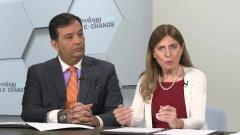
Treatment Pipeline for Alzheimer’s Disease
Drs McDade, Atri, Cohen, and Sabbagh discuss candidates drugs and various mechanisms of actions that are currently under evaluation for Alzheimer’s disease.
Episodes in this series

Marwan Sabbagh, MD: Dr McDade, can you give us an overview, we have a big pipeline with over 100 drugs, which most people do not realize, many of them are DMTs [disease-modifying therapies], many of them are monoclonal, targeting amyloid. Can you give us an overview and briefly mention the pipeline and the rationale for the different epitopes of amyloid?
Eric McDade, DO: Yes. One of the topics that Dr Cohen had mentioned, the difficulties in success we’ve had, has forced us to be quite broad in the approach to Alzheimer disease. The pipeline is right now quite robust and broad, contrary to the opinion of some who think it’s focused on amyloid, which I’ll talk about in a moment. That generally falls into precise mechanisms or general mechanisms, and then those precision or more general approaches are applied to our canonical pathology. Amyloid and tau, there’s a rather large and robust pipeline that’s associated with those. Then there are these noncanonical pathways, and again, those can be things like the immune inflammatory components of this. They can be related to the synaptic regenerative components of this. And even beyond pharmacotherapies, there’s a broad pipeline right now that includes things like deep brain stimulation. There’s entrainment studies essentially that are using noninvasive light frequencies to try to entrain a certain theta frequency within the brain that maybe helps resists some of the pathology.
How many of these will be successful? Again, probably relatively few of them. But what has happened now and what’s evolving is that we’re in a much better position to measure our therapies. And again, making sure it’s the right population, it’s the right target, and it’s the right dose. We’ve been missing those components of treating Alzheimer disease for so long that it’s made it difficult, and it’s made it seem like this is an untreatable disorder. Right now, the treatment still is primarily monotherapy. What’s also going to be a clear treatment paradigm that will evolve in Alzheimer disease is the recognition that because there are so many components that lead to the actual neurodegenerative component in the symptoms, there probably will be multiple therapies. And it will take on much more of a model that we think of with things like oncology, for instance, or cardiovascular disease, where we use different mechanisms that target different pathways. Those treatments are underway.
Within the amyloid domain right now, the most successful therapies thus far have been the immunotherapies that have been targeting the aggregated, or the plaques. The data seem to support that the lower you can get those amyloid plaque levels, the higher the likelihood there’s going to be some clinical benefit. There are therapies that are still evolving and focusing on things like decreasing the production or the development of the toxic forms of the amyloid pathology. Things like gamma secretase modulators, which are moving into the field after the failures of things like gamma secretase inhibitors and the base inhibitors. The immunotherapies that have been recently approved, and some of the data that were presented here at CTAD [Clinical Trials on Alzheimer’s Disease conference], however are increasingly focusing on the aggregated plaque forms of amyloid. Then some of these other amyloid targeting therapies will still evolve.
Transcript edited for clarity
Newsletter
Keep your finger on the pulse of neurology—subscribe to NeurologyLive for expert interviews, new data, and breakthrough treatment updates.


















































